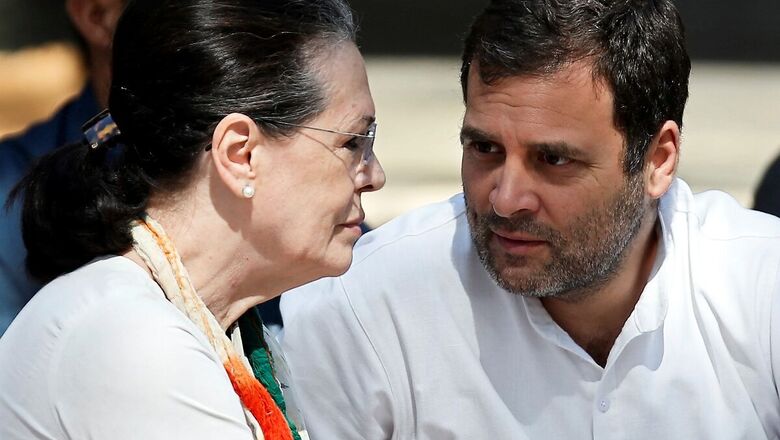
views
As predicted in my July 27 article, the Congress is attempting a course correction on Ayodhya. From Kamal Nath to Manish Tiwari to Priyanka Gandhi, many Congress leaders are busy saluting Lord Rama or trying to credit late Rajiv Gandhi with opening of lock at the disputed site in 1986 and holding shilanyas in Ayodhya in 1989.
However, making a clean shift is not easy for the grand old party. For decades, the Congress, under Rajiv, P V Narasimha Rao, Sitaram Kesri and Sonia Gandhi’s leadership, faced many predicaments in either supporting Ram temple or staying on as a mute spectator in events relating to Ayodhya. The party’s successive political resolutions kept parroting a line that it will abide by a court verdict or favour an amicable out of court settlement. But the posture had few takers outside its minority constituency.
Instinctively, when Rahul Gandhi was AICC chief during December 2017-May 2019, he was unable to reiterate his father’s stand taken in 1989 when, as prime minister, Rajiv Gandhi had launched his Lok Sabha campaign on the bank of river Saryu in Ayodhya promising “Ram Rajya.” Rajiv and his home minister Buta Singh had even performed “Shilanyas” there. In fact, throughout the 1986-89 period, the Congress chief ministers of Uttar Pradesh, Veer Bahadur Singh and ND Tiwari had tried to occupy “Ayodhya centrestage” and twice came forward with a "Rajiv formula" to pave the way for construction of a Ram temple in Ayodhya.
Rajiv’s move to perform Shilanyas had come under criticism from many quarters. While the BJP and Vishwa Hindu Parishad had decried it as a half-hearted attempt to garner votes, liberals, media, socialists and non-BJP opposition had severely criticised Rajiv’s ‘blatant attempt’ to play a ‘ Hindu card.’
In his book, Ayodhya – December 6, 1992<,em> (Penguin 2005) former prime minister P V Narasimha Rao had also blamed Rajiv. Wondering whether the shilanyas Rajiv allowed in Ayodhya in 1989 took place on “disputed” or “undisputed” land, Rao cited several government records and statements to indicate that it was the latter.
In the 202-page book, Rao, largely blamed for events that led to demolition of a 16th century mosque, made a feeble attempt to absolve himself of the blame for demolition, citing “factual, constitutional, political and legal” aspects of the events in Ayodhya. He had insisted that what happened in Ayodhya on that Sunday of December 6, 1992 was beyond his control.
“Technically and legally”, the actual possession of the site was not with the Centre, he had argued. Rao claimed that when the mosque was being pulled down, the magistrate on duty had refused to allow the central forces stationed in the town to advance to the site, saying the state government had given him written orders not to act. “Thus, the exact moment when the forces could have scattered the crowd, it was turned back deliberately by official order. Here were two governments, creatures of the same Constitution, come into confrontation. So the central forces had to act according to the Constitution; there was no way out,” Rao wrote with a sense of anguish.
In the introduction, the former Prime Minister insisted that he didn’t write Ayodhya book to justify or vindicate himself. He only wanted to reveal the “truth” about events and motives and point out certain “grey aspects” in the Constitution.
Rao, whose credibility took a nosedive after the demolition, said the answer to the “inevitable and irresistible” question of why the Centre had failed to slap Article 356 on the state in order to save the mosque can be found in the Supreme Court’s observations on the constitutional provision. That lengthy answer takes up a rather large portion of the book.
“Not one of my colleagues who suggested President’s rule came up basing it either on objective conditions prevailing in UP nor had they any idea of how President’s rule could be imposed in these specific conditions obtaining in UP on December 6, 1992 as distinguishable from the introduction of President’s rule elsewhere in normal times,” Rao observed.
The thrust of the former Prime Minister’s argument is that while the Kalyan government and the BJP were solely responsible for the “wanton vandalism”, his Congress colleagues, too, had been guided by “political and vote-earning considerations”. “They had already made up their mind that one person had to be made historically responsible for the tragedy. They got a stick to beat me with. I understood it.”
In a chapter titled, The Building Blocks of Dispute, Rao claims that these Congress leaders had made a crucial calculation well before the mosque fell on December 6, 1992.
“If there had been success (in preventing any incident — as had seemed likely initially when Rao held behind-the-scenes consultations with Vishwa Hindu Parishad and Rashtriya Swayamsevak Sangh leaders) they would readily share the credit or appropriate it for themselves. So they were playing either for success or an alibi,” Rao had lamented his former cabinet colleagues.
















Comments
0 comment